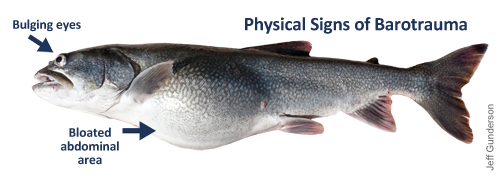January 21, 2016 at 4:27 pm
 By IFW Fisheries Biologist Kevin Dunham
Togue and other bottom-dwelling fish often have expanded swim bladders after being pulled up rapidly from deep water. This is known as barotrauma, usually when they are caught from water deeper than 30 feet. Barotrauma is caused by the rapid expansion of gases in the swim bladder and other tissues as fish are retrieved to the surface.
When fishing near or on the bottom, try to bring your fish to the surface slowly to allow it time to expel gases built-up from water pressure changes.
If a fish has a normal-sized swim bladder while it is swimming 60 feet below the surface, its swim bladder could double, even triple, as a fisherman gives it a quick trip to the surface.
A ballooning swim bladder is a non-issue if the fish will be kept. If it's a catch-and-release kind of fish, however, its life is in jeopardy. With the equivalent of a beach ball in its gut the fish can't swim back down.
The first thing is to understand the signs of a fish struggling with barotrauma, or "pressure" trauma. The physical signs of barotrauma are:
By IFW Fisheries Biologist Kevin Dunham
Togue and other bottom-dwelling fish often have expanded swim bladders after being pulled up rapidly from deep water. This is known as barotrauma, usually when they are caught from water deeper than 30 feet. Barotrauma is caused by the rapid expansion of gases in the swim bladder and other tissues as fish are retrieved to the surface.
When fishing near or on the bottom, try to bring your fish to the surface slowly to allow it time to expel gases built-up from water pressure changes.
If a fish has a normal-sized swim bladder while it is swimming 60 feet below the surface, its swim bladder could double, even triple, as a fisherman gives it a quick trip to the surface.
A ballooning swim bladder is a non-issue if the fish will be kept. If it's a catch-and-release kind of fish, however, its life is in jeopardy. With the equivalent of a beach ball in its gut the fish can't swim back down.
The first thing is to understand the signs of a fish struggling with barotrauma, or "pressure" trauma. The physical signs of barotrauma are:
- Bloated abdominal area,
- Bulging eyes,
- Balloon-like tissue protruding from the mouth or other areas of the body (sometimes).
Categories